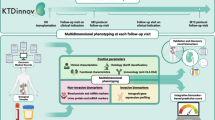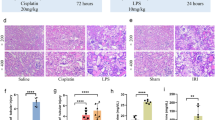Abstract
Protosappanin A as one major and effective ingredient from Caesalpinia sappan L. exhibited antirejection activity obviously in heart-transplanted rat. The present study was designed to screen out the potential target genes of protosappanin A with microarray technology and reveal some molecular mechanism of immunosuppressive effect. Rats performed with ectopic peritoneal heart transplantation were randomized into three groups receiving different treatments for 7 days: protosappanin A group (25 mg kg−1), cyclosporine A group (10 mg kg−1), and control group. The differentially expressed genes responding to protosappanin A were analyzed with microarrays. Among common differentially expressed genes, the ones of interest were selected for further evaluation by real-time quantitative reverse transcriptase polymerase chain reaction (qRT-PCR), Western blot, immunochemistry, immunofluorescence, and ELISA. Among the 146 common differentially expressed genes, NF-κB and related genes like IκBa, IFN-r, and IP10 were selected for verification. The results of qRT-PCR, Western blot, immunochemistry, and ELISA showed that protosappanin A significantly reduced the expression of NF-κB, IFN-r, and IP10 (p < 0.05) and increased IκBa expression (p < 0.05) in graft. Moreover, the immunochemistry staining of NF-κB and IκBa was mainly observed in infiltrating mononuclear cells. Strikingly, immunofluorescent staining localized NF-κB to the TCR-positive T cells in graft. Furthermore, protosappanin A exhibited inhibitory effect on T cell proliferation in recipients after 7-day treatment. In conclusion, protosappanin A might act on T cells through inhibiting NF-κB activation and downstream gene expressions of IFN-r and IP10, meanwhile reducing T cell proliferation responding to alloantigen, so as to induce immunosuppressive effect. The results encourage a potential therapeutic evaluation of protosappanin A for clinical organ transplantation or other T cell-mediated immune disorders. Additionally, our study also verified the feasibility of microarray utilization in Chinese herb research to explore molecular mechanism and promote development of scientific theories.






Similar content being viewed by others
Abbreviations
- PrA:
-
Protosappanin A
- CsA:
-
Cyclosporin A
- NF-κB:
-
Nuclear factor kappa B
- IκBa:
-
Inhibitor of nuclear factor kappa B alpha
- IFN-r:
-
Interferon-gamma
- IP10:
-
Interferon-gamma-inducible protein 10
- qRT-PCR:
-
Real-time quantitative reverse transcriptase polymerase chain reaction
- FITC:
-
Fluorescein isothiocyannate
- TRITC:
-
Tetramethylrhodamine isothiocyannate
References
Badami S, Moorkoth S, Rai SR, Kannan E, Bhojraj S (2003) Antioxidant activity of Caesalpinia sappan heartwood. Biol Pharm Bull 26(11):1534–1537
Baek NI, Jeon SG, Ahn EM, Hahn JT, Bahn JH, Jang JS, Cho SW, Park JK, Choi SY (2000) Anticonvulsant compounds from the wood of Caesalpinia sappan L. Arch Pharm Res 23(4):344–348
Baldwin AS (1996) The NF-κB and IκB proteins: new discoveries and insights. Annu Rev Immunol 14:649–681
Chen CF, Leung AY (2007) Gene response of human monocytic cells for the detection of antimigraine activity of feverfew extracts. Can J Physiol Pharmacol 85(11):1108–1115
Cheng WY, Wu SL, Hsiang CY, Li CC, Lai TY, Lo HY, Shen WS, Lee CH, Chen JC, Wu HC, Ho TY (2008) Relationship between San-Huang-Xie-Xin-Tang and its herbal components on the gene expression profiles in HepG2 cells. Am J Chin Med 36(4):783–797
Colvin BL, Thomson AW (2002) Chemokines, their receptors, and transplant outcome. Transplantation 74(2):149–155
Cooper M, Lindholm P, Pieper G, Seibel R, Moore G, Nakanishi A, Dembny K, Komorowski R, Johnson C, Adams M, Roza A (1998) Myocardial nuclear factor-kappa B activity and nitric oxide production in rejecting cardiac allografts. Translantation 66(7):838–844
Erickson LM, Pan F, Ebbs A, Kobayashi M, Jiang H (2003) Microarray-based gene expression profiles of allograft rejection and immunosuppression in the rat heart transplantation model. Transplantation 76(3):582–588
Finn PW, Stone JR, Boothby MR, Perkins DL (2001) Inhibition of NF-kappaB-dependent T cell activation abrogates acute allograft rejection. J Immunol 167:5994–6001
Gramowski A, Jugelt K, Stuwe S, Schulze R, McGregor GP, Wartenberg-Demand A, Loock J, Schroder O, Weiss DG (2006) Functional screening of traditional antidepressants with primary cortical neuronal networks grown on multielectrode neurochips. Eur J NeuroSci 24(2):455–465
Green D (2003) Death and NF-kappaB in T cell activation: life at the edge. Mol Cell 11(3):551–552
Hikino H, Taguchi T, Fujimura H, Hiramatsu Y (1977) Antiinflammatory principles of Caesalpinia sappan wood and of Haematoxylon campechianum wood. Planta Med 31(3):214–220
Iizuka N, Oka M, Yamamoto K, Tangoku A, Miyamoto K, Miyamoto T, Uchimura S, Hamamoto Y, Okita K (2003) Identification of common or distinct genes related to antitumor activities of a medicinal herb and its major component by oligonucleotide microarray. Int J Cancer 107(4):666–672
Jian Wu, Jingbo H, Maomao Z, Yongpeng Z, Bo Y (2008) Protosappanin A, a immunosuppressive constituent from Chinese herb, prolongs graft survival and attenuates acute rejection in rat heart allografts. Transplant Proc 40(10):3719–3722
Jiankuo M, Xingbing W, Baojun H (2003) Peptide nucleic acid antisense prolongs skin allograft survival by means of blockade of CXCR3 expression directing T cells into graft. J Immunol 170(3):1556–1565
Jones ND, Van Maurik A, Hara M, Spriewald BM, Witzke O, Morris PJ, Wood KJ (2000) CD40-CD40 ligand-independent activation of CD8+ T cells can trigger allograft rejection. J Immunol 165(2):1111–1118
Kanehisa M, Goto S (2000) KEGG: Kyoto Encyclopedia of Genes and Genomes. Nucleic Acids Res 28(1):27–30
Kapoor A, Morita K, Engeman TM, Koga S, Vapnek EM, Hobart MG, RL F (2000) Early expression of interferon-gamma inducible protein 10 and monokine induced by interferon-gamma in cardiac allografts is mediated by CD8+ T cells. Transplantation 69:1147–1155
Kendziorski C, Irizarry RA, Chen K-S, Haag JD, Gould NM (2005) On the utility of pooling biological samples in microarray experiments. PNAS 102(12):4252–4257
Kim EC, Hwang YS, Lee HJ, Lee SK, Park MH, Jeon BH, Jeon CD, Yu HH, You YO (2005) Caesalpinia sappan induces cell death by increasing the expression of p53 and p21WAF1/CIP1 in head and neck cancer cells. Am J Chin Med 33(3):405–414
Kira VM, Fagundes DJ, Bandeira COP, Kaufman O, Fagundes ATN, Ortiz V (2008) Effects of repeated extracorporeal shock wave on kidney apoptosis of normal and diabetic Rat. Investig Urol 34(1):91–96
Lu B, Ebensperger C, Dembic Z, Wang Y, Kvatyuk M, Lu T, Coffman RL, Pestka S, Rothman PB (1998) Targeted disruption of the interferon-gamma receptor 2 gene results in severe immune defects in mice. Proc Natl Acad Sci USA 95(14):8233–8238
Mason NJ, Artis D, Hunter CA (2004) New lessons from old pathogens: what parasitic infections have taught us about the role of nuclear factor-kappaB in the regulation of immunity. Immunol Rev 201:48–56
Melter M, Exeni A, Reinders ME, Fang JC, McMahon G, Ganz P, Hancock WW, Briscoe DM (2001) Expression of the chemokine receptor CXCR3 and its ligand IP-10 during human cardiac allograft rejection. Circulation 104(21):2558–2564
Miura M, Morita K, Kobayashi H, Hamilton TA, Burdick MD, Strieter RM, Fairchild RL (2001) Monokine induced by IFN-gamma is a dominant factor directing T cells into murine cardiac allografts during acute rejection. J Immunol 167(6):3494–3504
Mizuarai S, Irie H, Schmatz DM, Kotani H (2008) Integrated genomic and pharmacological approaches to identify synthetic lethal genes as cancer therapeutic targets. Curr Mol Med 8(8):774–783
Oh SR, Kim DS, Lee IS, Jung KY, Lee JJ, Lee HK (1998) Anticomplementary activity of constituents from the heartwood of Caesalpinia sappan. Planta Med 64(5):456–458
Ono K, Lindsey ES (1969) Improved technique of heart transplantation in rats. J Thorac Cardiovasc Surg 57(2):225–229
Ping Zhou J, Balin S, Mashayekhi M (2005) Transplantation tolerance in NF-kappaB-impaired mice is not due to regulation but is prevented by transgenic expression of Bcl-xL. J Immunol 174:3447–3453
Suzuki J, Morishita R, Amano J, Kaneda Y, Isobe M (2000) Decoy against nuclear factor-kappa B attenuates myocardial cell infiltration and arterial neointimal formation in murine cardiac allografts. Gene Ther 7(21):1847–1852
Wenner CA, Guler ML, Macatonia SE, O’Garra A, Murphy KM (1996) Roles of IFN-r and IFN-r in IL-12-induced T helper cell-1 development. J Immunol 156:1442
Xavier LL, Viola GG, Ferraz AC, Da Cunha C, Deonizio JM, Netto CA, Achaval M (2005) A simple and fast densitometric method for the analysis of tyrosine hydroxylase immunoreactivity in the substantia nigra pars compacta and in the ventral tegmental area. Brain Res Brain Res Protoc 16(1–3):58–64
Ye M, Xie WD, Lei F, Meng Z, Zhao YN, Su H, Du LJ (2006) Brazilein, an important immunosuppressive component from Caesalpinia sappan L. Int Immunopharmacol 6(3):426–432
Zarkhin V, Sarwal MM (2008) Microarrays: monitoring for transplant tolerance and mechanistic insights. Clin Lab Med 28(3):385–410
Zhao DX, Hu Y, Miller GG, Luster AD, Mitchell RN, Libby P (2002) Differential expression of the IFN-gamma-inducible CXCR3-binding chemokines, IFN-inducible protein 10, monokine induced by IFN, and IFN-inducible T cell alpha chemoattractant in human cardiac allografts: association with cardiac allograft vasculopathy and acute rejection. J Immunol 169(3):1556–1560
Zhoua P, Hwanga KW, Paluckia DA, Guob Z, Boothbyc M, Newellb KA, Alegrea M-L (2003) Impaired NF-κB activation in T cells permits tolerance to primary heart allografts and to secondary donor skin grafts. Am J Transplant 3:139–147
Acknowledgments
Our projects are supported by the National Nature Science Foundation of China (C03020504), the Heilongjiang Province Nature Science Foundation (D200660), the Heilongjiang Province Nature Foundation of Great Subject (ZJY03-7), and Heilongjiang Province Scientific Technique Project (GC02C122).
Author information
Authors and Affiliations
Corresponding author
Additional information
J. Wu and M. Zhang contributed equally in the study.
Rights and permissions
About this article
Cite this article
Wu, J., Zhang, M., Jia, H. et al. Protosappanin A induces immunosuppression of rats heart transplantation targeting T cells in grafts via NF-κB pathway. Naunyn-Schmied Arch Pharmacol 381, 83–92 (2010). https://doi.org/10.1007/s00210-009-0461-5
Received:
Accepted:
Published:
Issue Date:
DOI: https://doi.org/10.1007/s00210-009-0461-5




